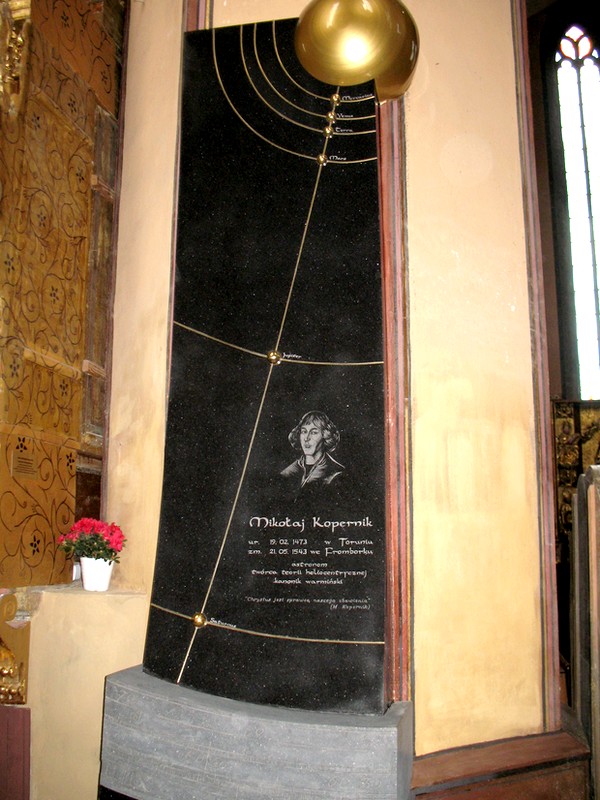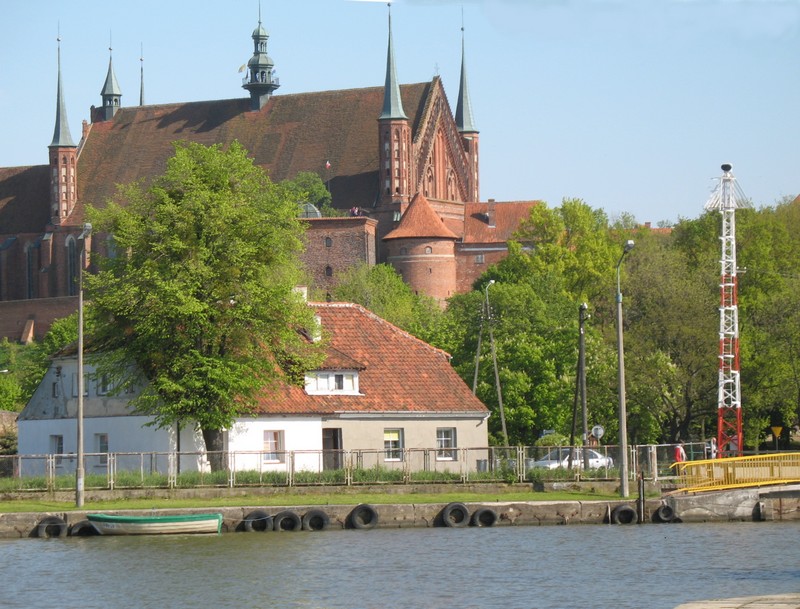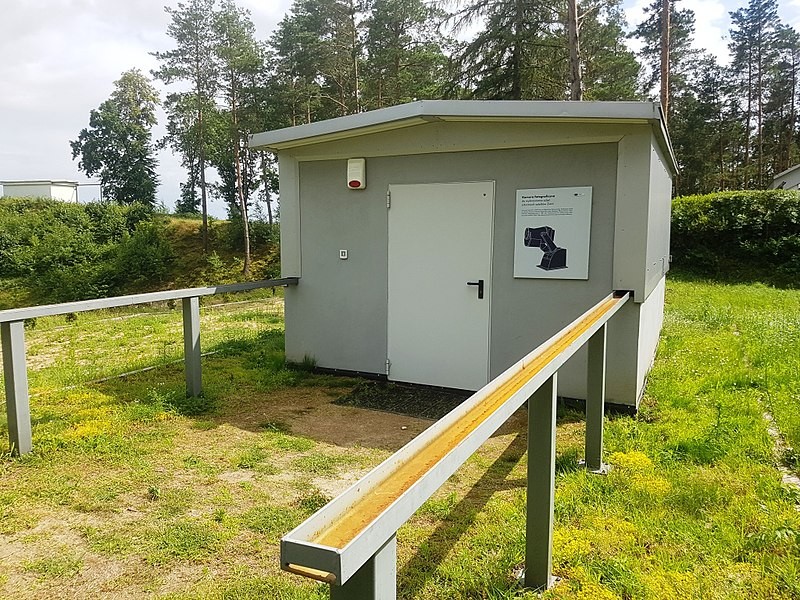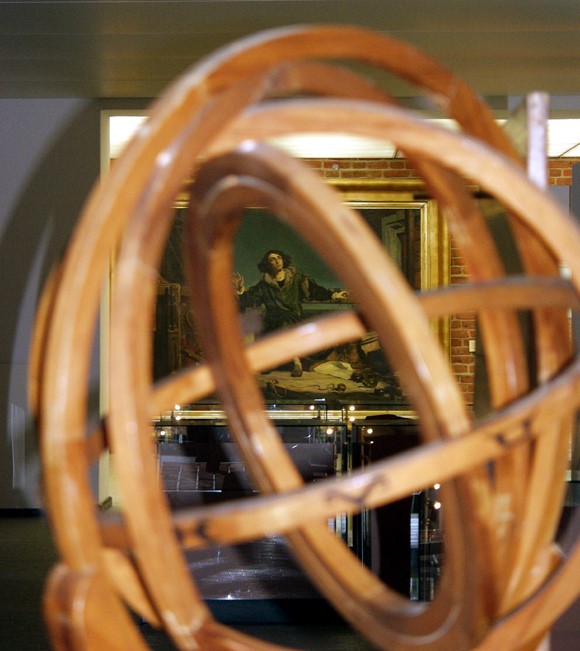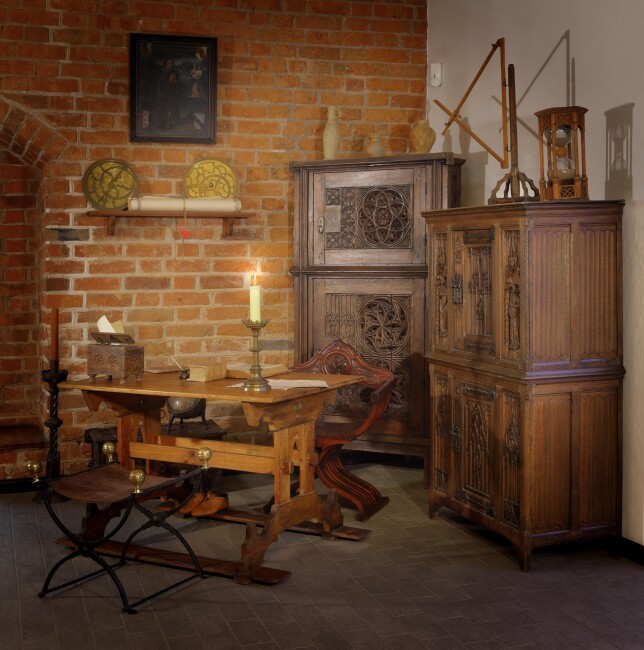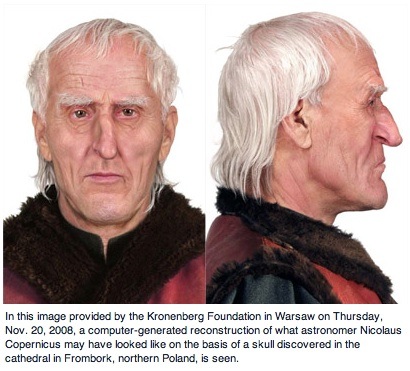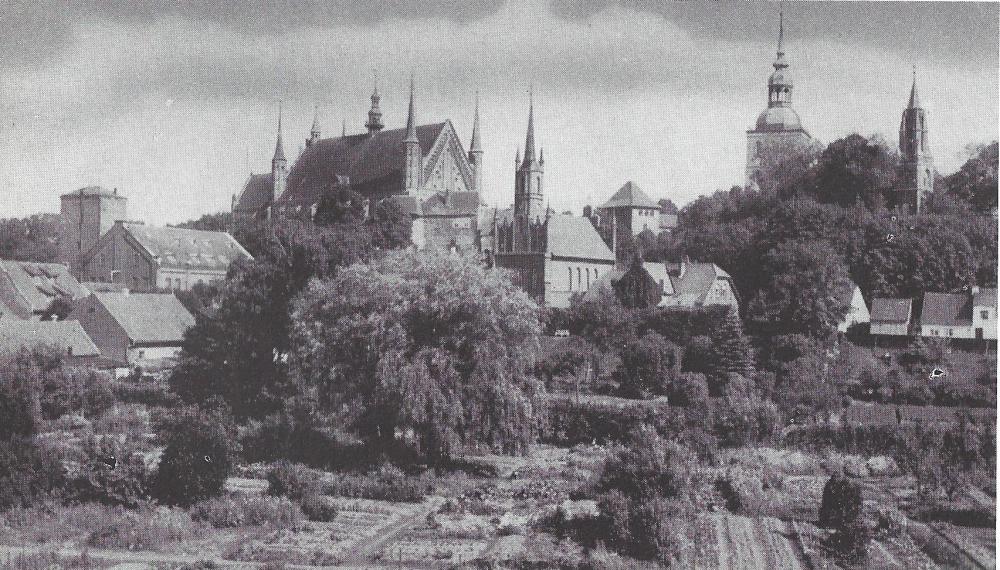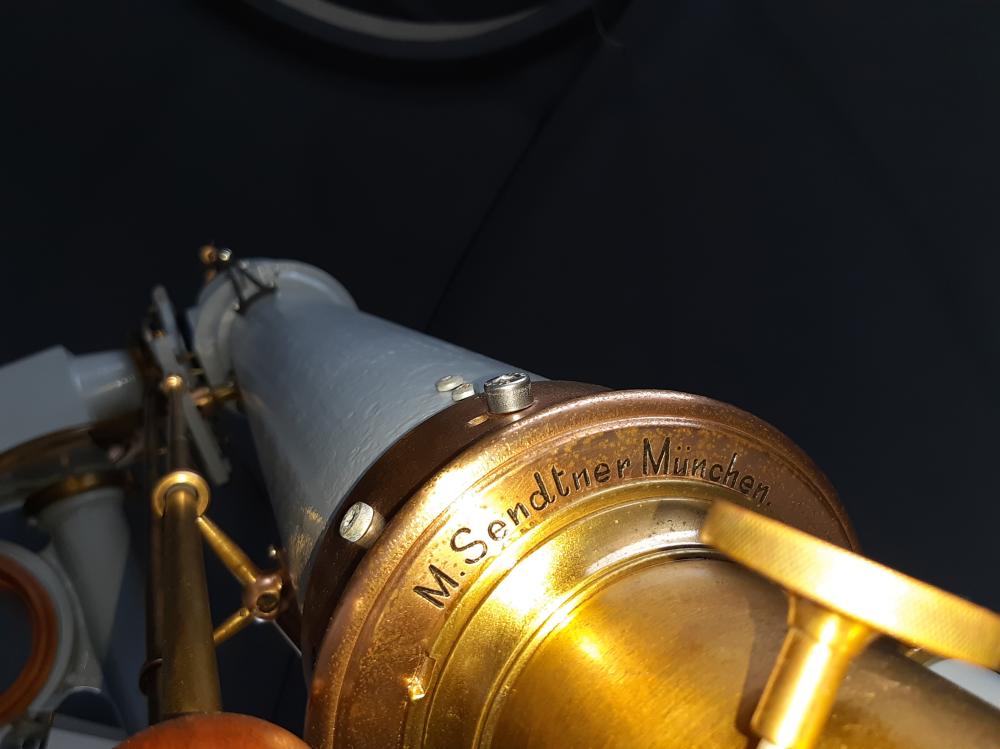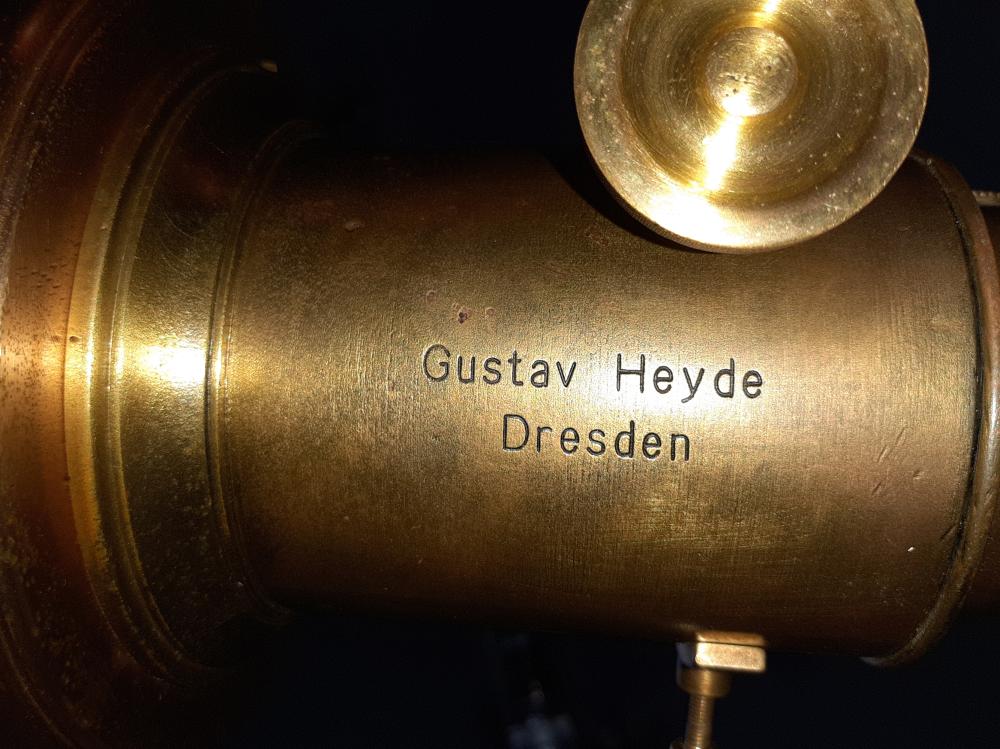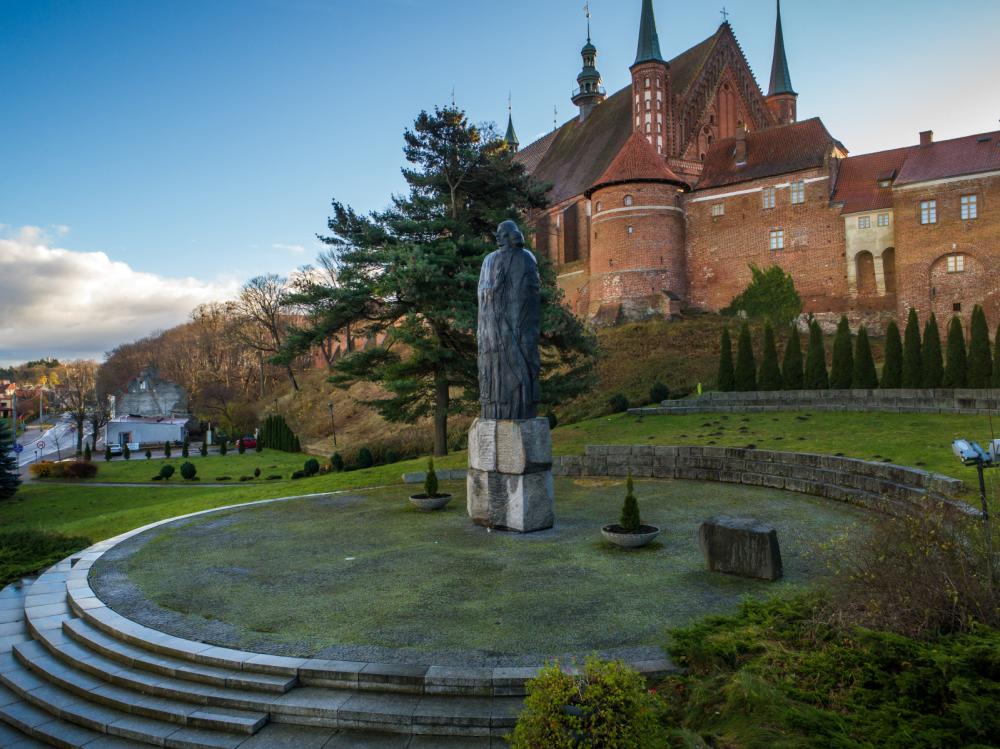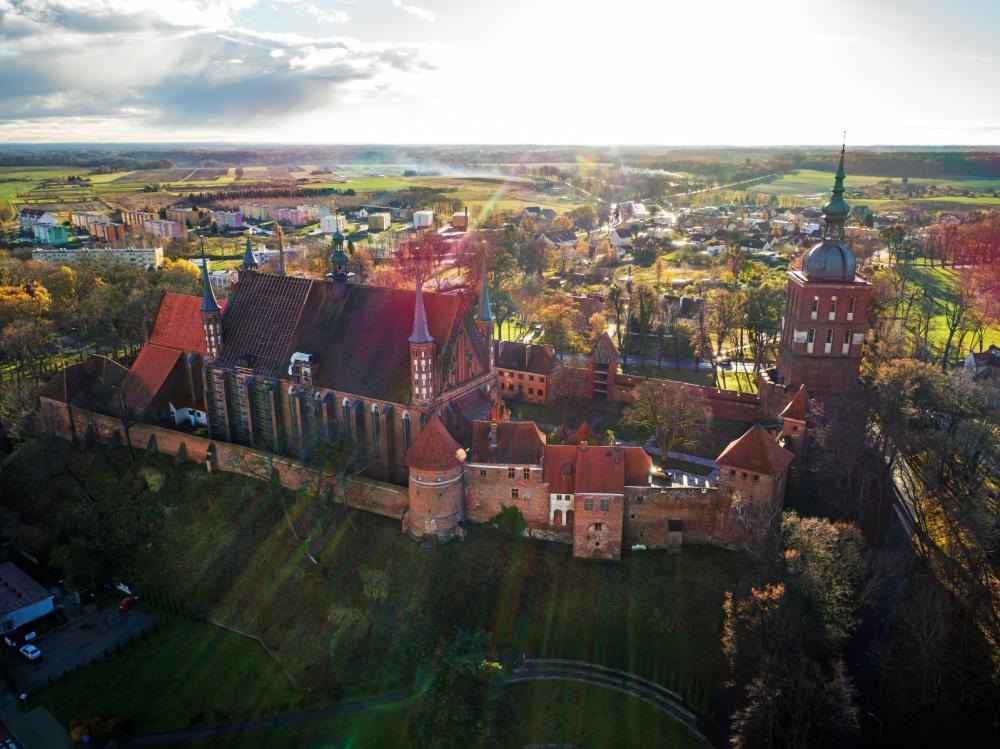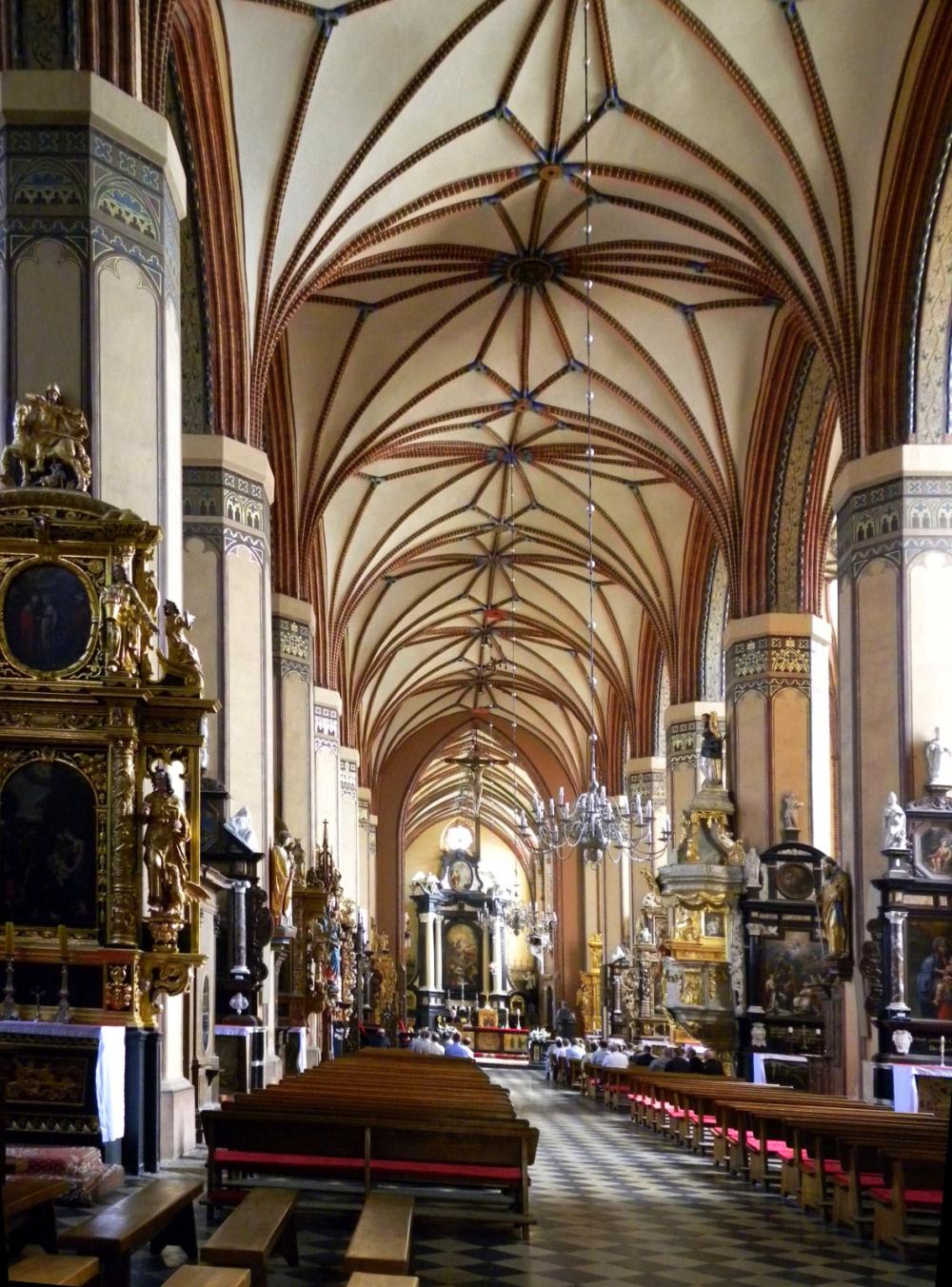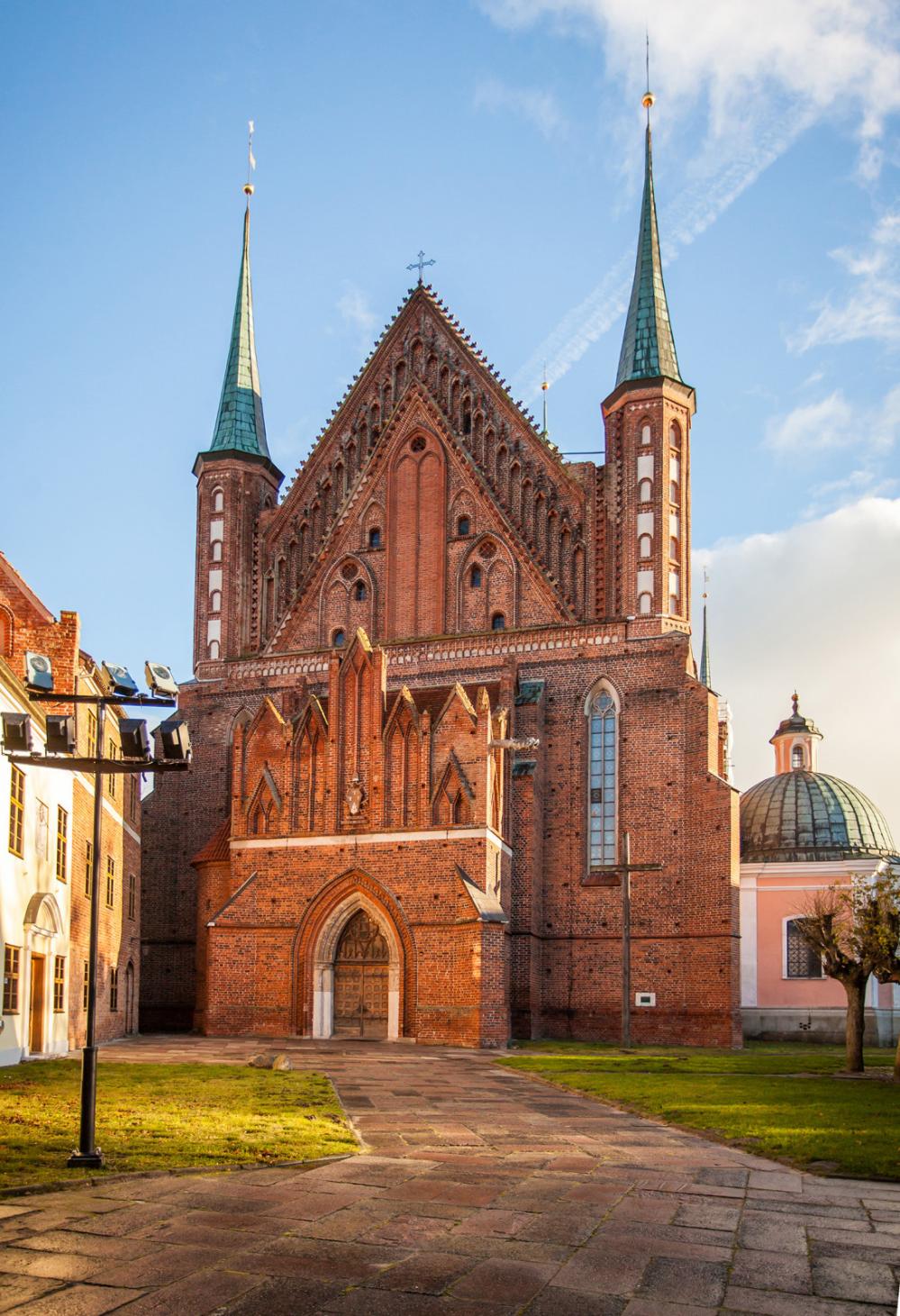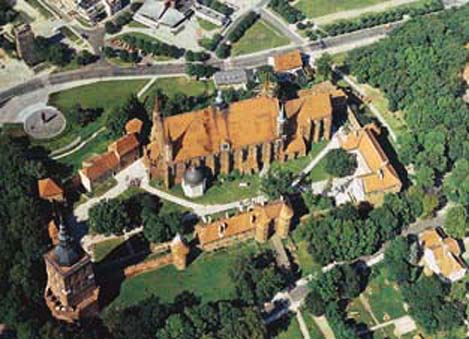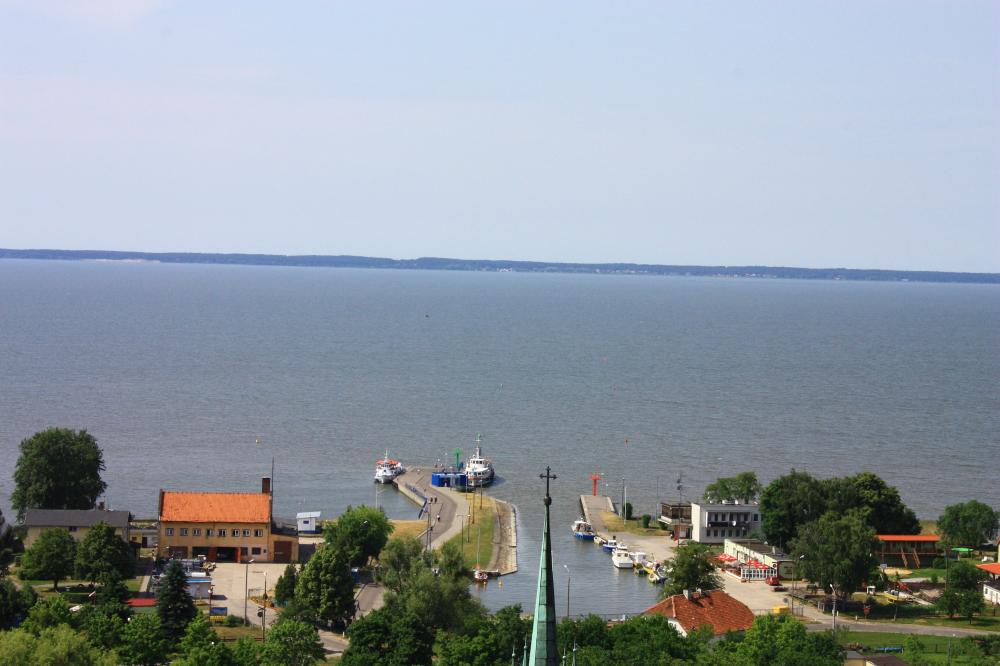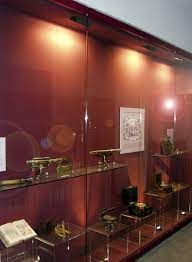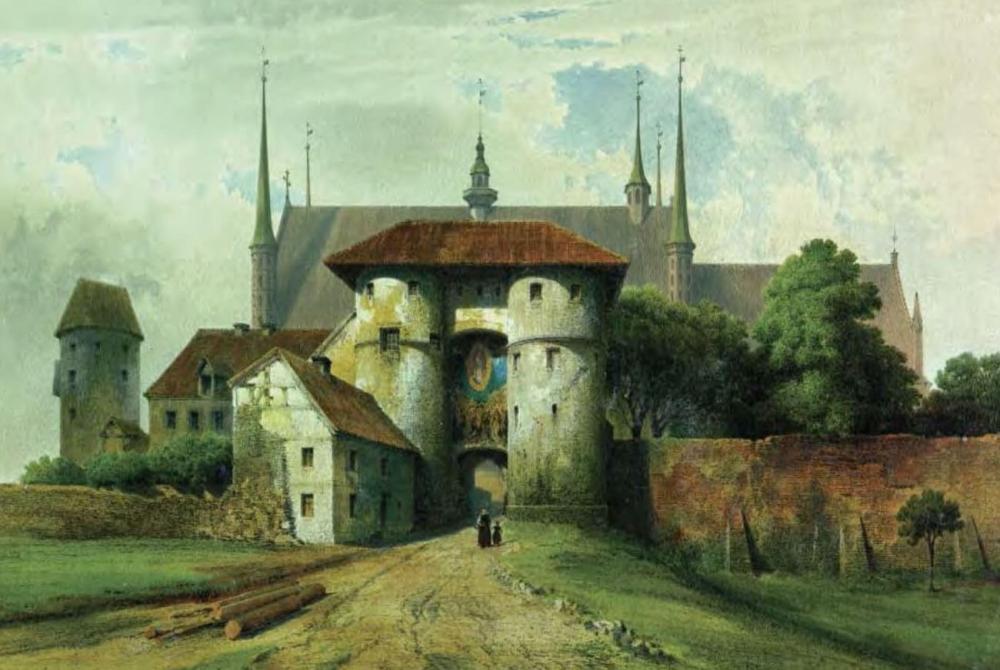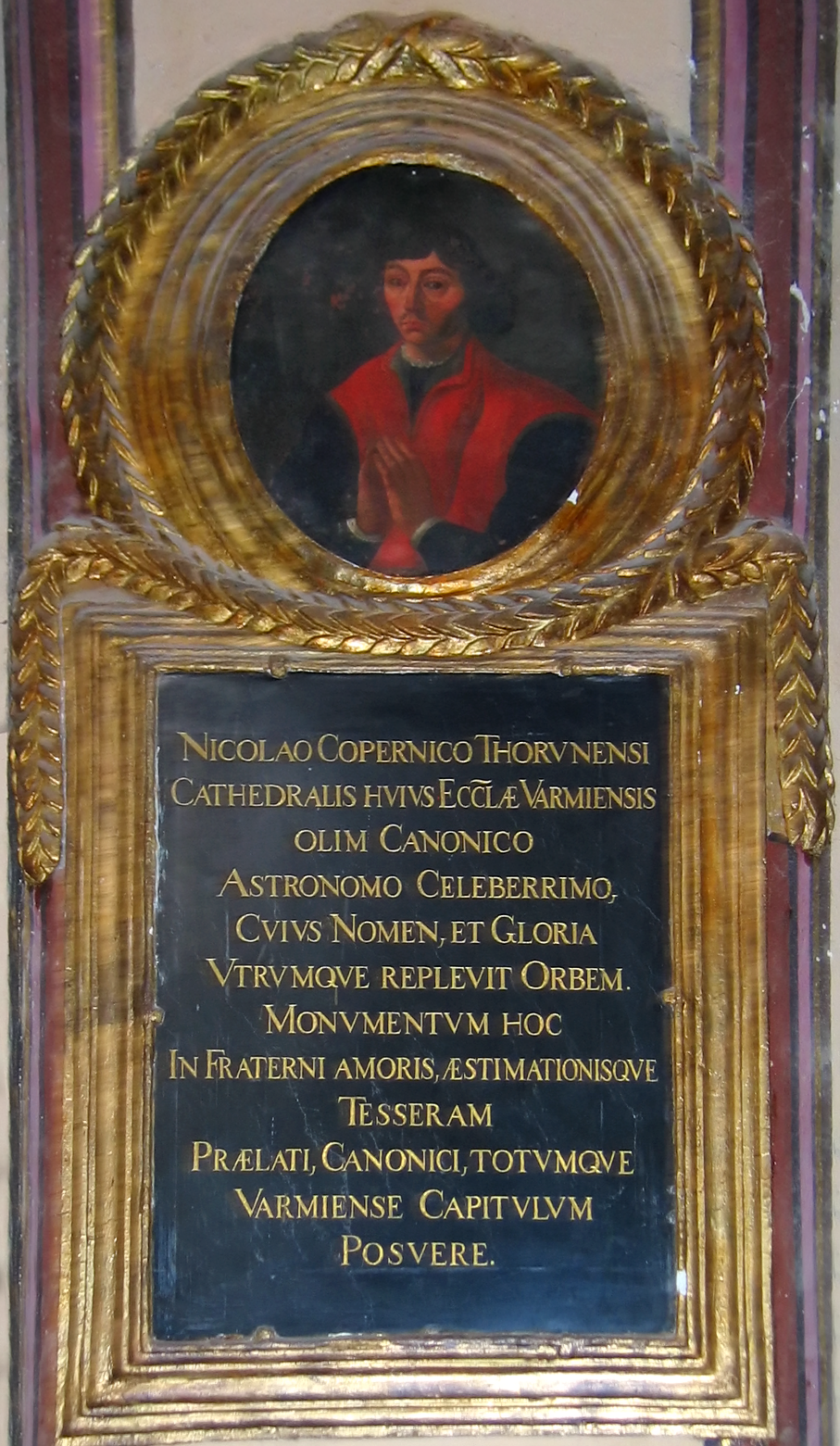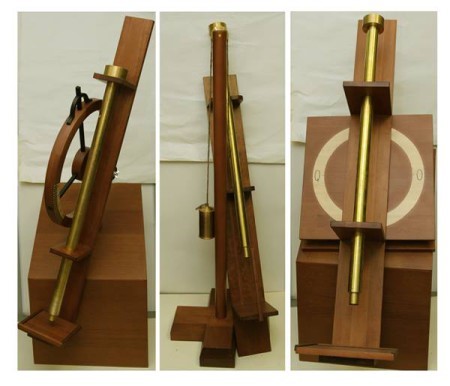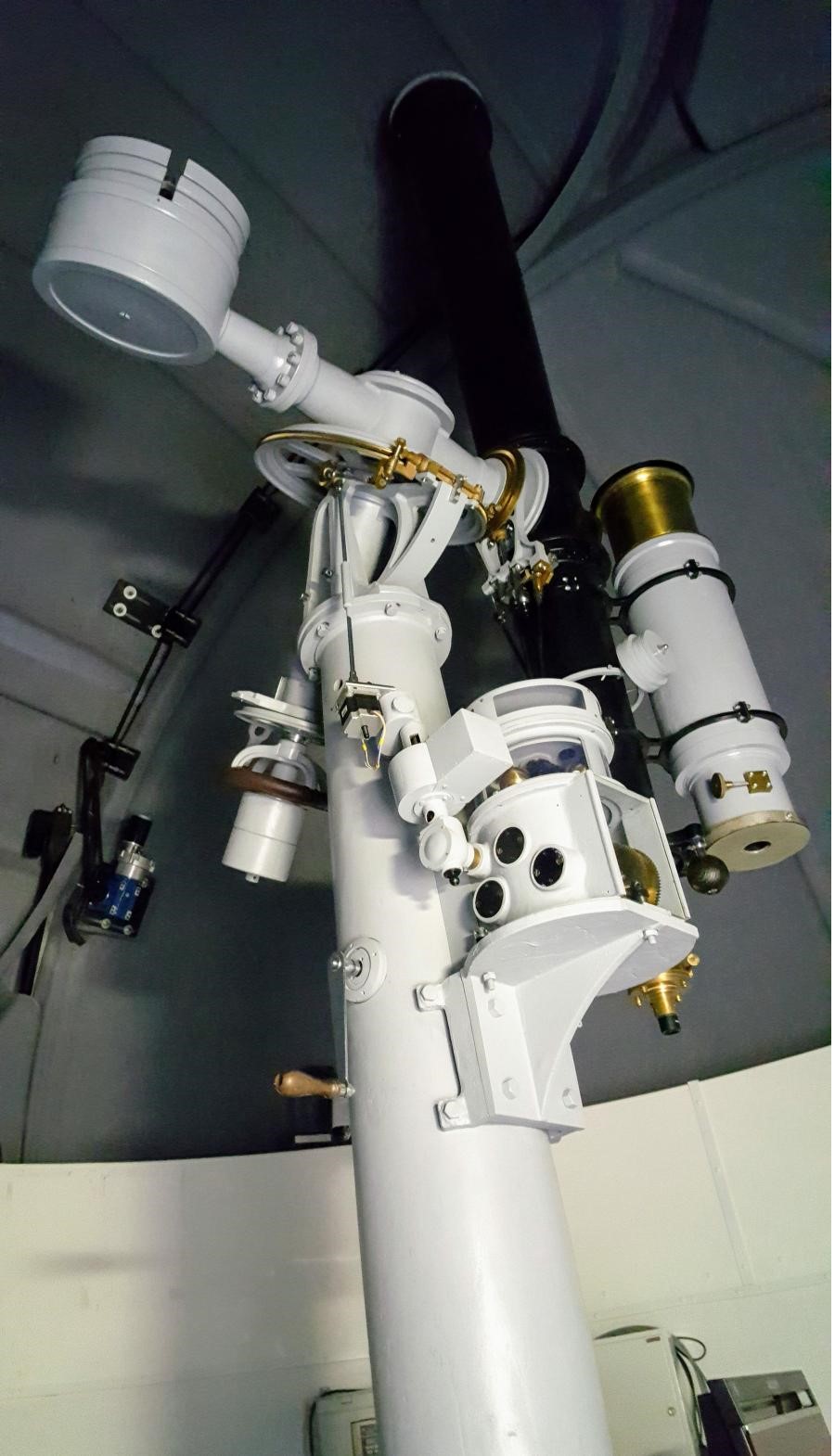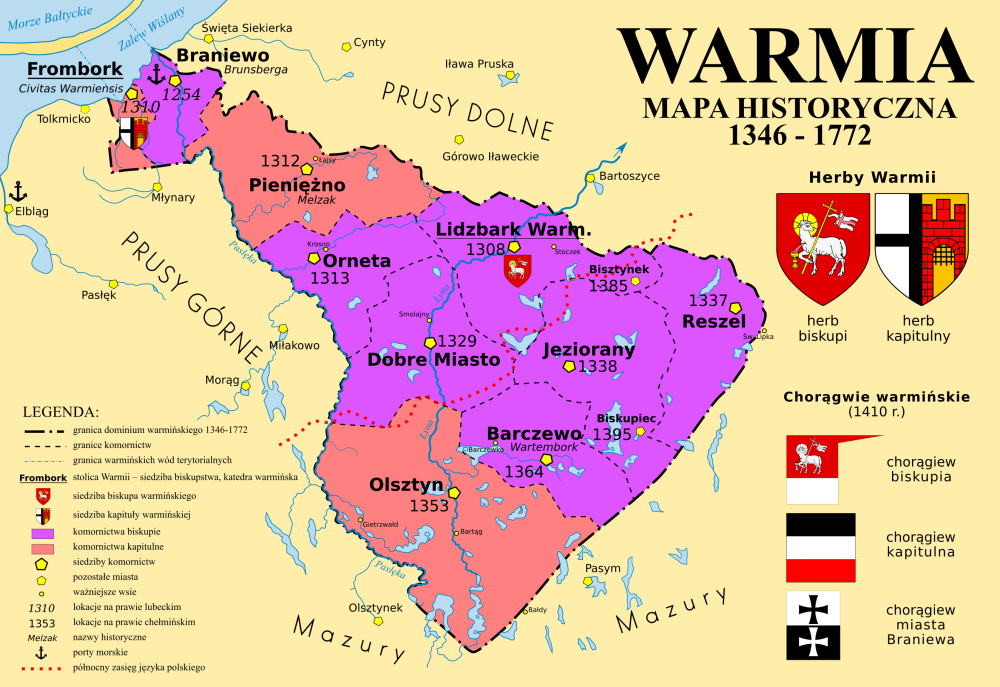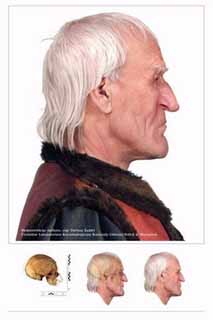
Category of Astronomical Heritage: tangible immovable
Copernicus observing site in Frauenburg / Frombork, Poland

Description
Geographical position
Copernicus observing site (Cathedral and Copernicus Tower), ul. Katedralna 8, 14-530 Frombork (Frauenburg), Poland
Location
Latitude 54.356765° N, Longitude 19.680879° E, Elevation 70m (top of Belfry) above mean sea level.
IAU observatory code
-
Description of (scientific/cultural/natural) heritage
Frauenburg/Frombork on the eastern shore of the Vistula Lagoon, founded in 1288, was the seat of the Warmian cathedral chapter since 1282. The Gothic Archcathedral Basilica of the Assumption of the Blessed Virgin Mary and Saint Andrew (Bazylika Archikatedralna Wniebowzięcia Najświętszej Maryi Panny i św. Andrzeja Apostola) (1388), Basilica minor, is a landmark on the Cathedral Hill.
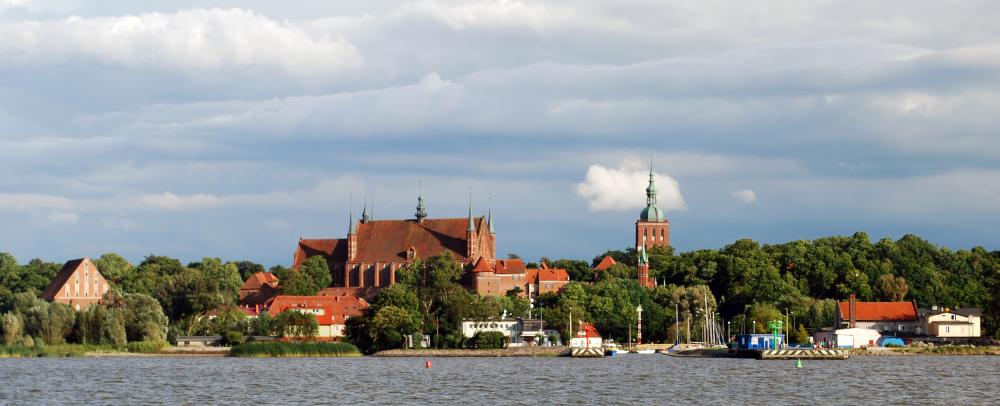
Fig. 1. View of the old town of Frombork/Frauenburg from the Vistula Lagoon (CC3, Polimerek)

Fig. 2. Cathedral in Frombork/Frauenburg (CC3, Agnieszka Kaczmarek)
Nicolaus Copernicus was Canon 1497, Capitular 1512 to 1516, and stayed since 1517 in Frombork / Frauenburg. Copernicus had different functions in the Warmia Cathedral Chapter: Chancellor and visitor of the Chapter’s property, Commissioner of Warmia, general administrator of the bishopric (1510 to 1543).
In Frombork, Copernicus wrote the main part of his opus magnum De revolutionibus orbium coelestium (On the Revolutions of the Heavenly Spheres), printed in 1543 in Nuremberg by Johannes Petreius.
In this publication, he presented his heliocentric system with the ground-breaking introduction:
"The first and the highest of all is the sphere of the fixed stars, which contains itself [...]. It is followed by the first of the planets, Saturn [...]. After Saturn, Jupiter [...]. Then Mars [...]. The annual revolution takes the series' fourth place, which contains the Earth, as I said, together with the Lunar sphere [...]. In the fifth place Venus [...]. Lastly, the sixth place is held by Mercury [...]. At rest, however, in the middle of everything is the Sun. For in this most beautiful temple, who would place this lamp in another or better position than that fr

Fig. 3a. Cathedral in Frombork/Frauenburg (CC3, Holger Weinandt)
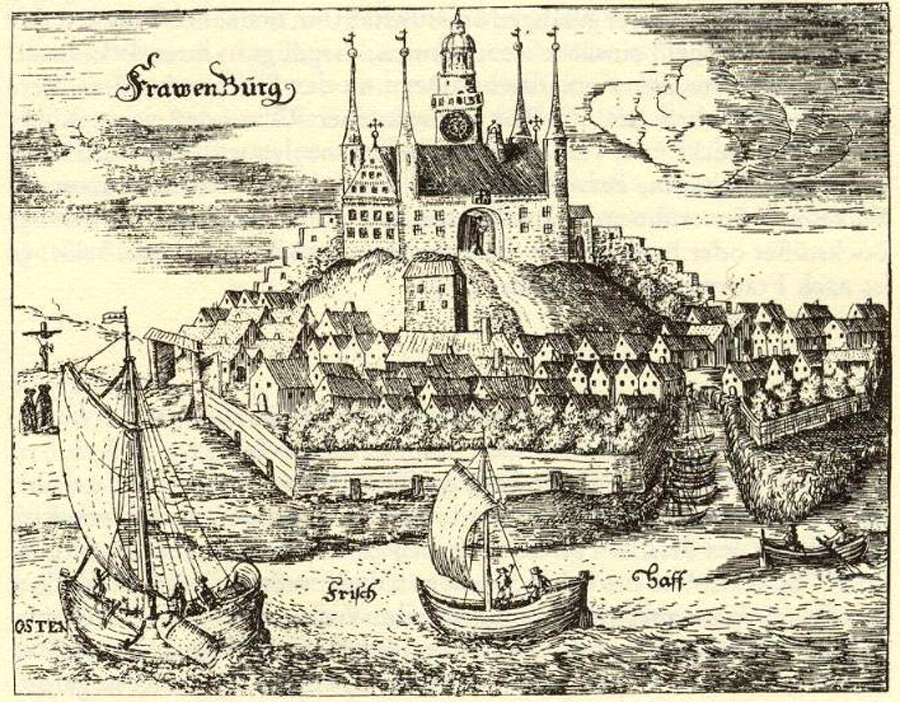
Fig. 3b. Frombork/Frauenburg (Christoph Hartknoch, 1684)
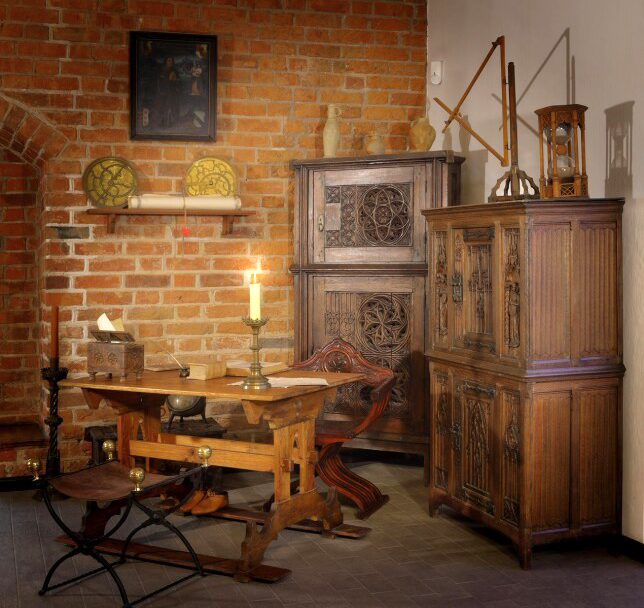
Fig. 3c. Study room for a Renaissance scholar like Copernicus in Frombork/Frauenburg, Copernicus Tower
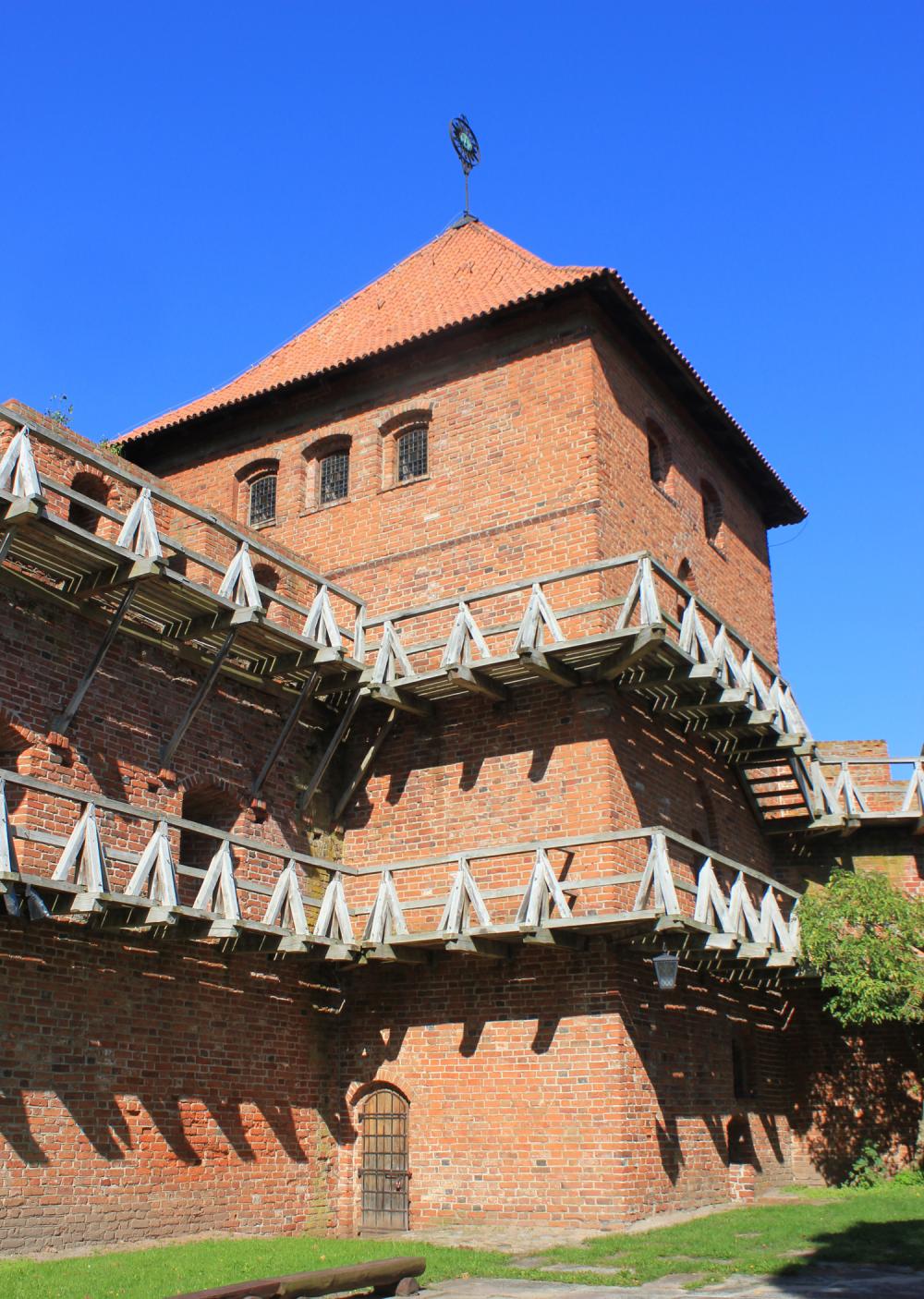
Fig. 3d. Copernicus Tower in Frombork/Frauenburg (CC3, Julian Nyca)
A Copernicus statue was erected by the "Society of Warmia and Masury", mid-1950s, replacing an older statue, erected by Emperor Wilhelm II.
In the center of the town of Frauenburg is a sitting Copernicus statue.
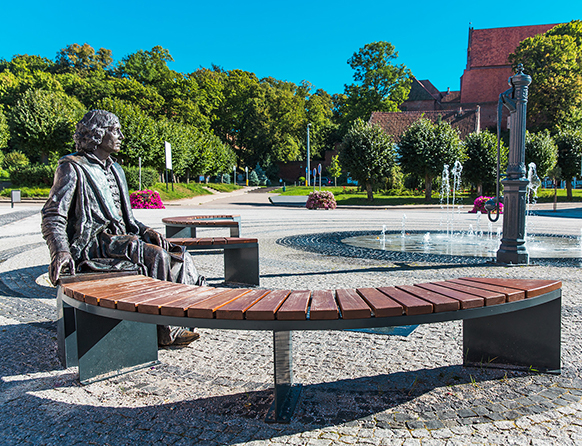
Fig. 4a. Statue of Nicolaus Copernicus (Mazury.Travel)
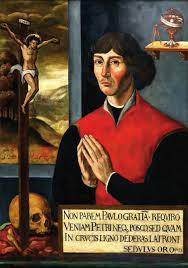
Fig. 4b. Nicolaus Copernicus (Portrait by Karol Hemmerlein)
The fortified church with parapet walk offered place for astronomical observations with moveable instruments.
The Copernicus Tower, part of the Cathedral complex, is a site, where Copernicus may have done his observations and research.
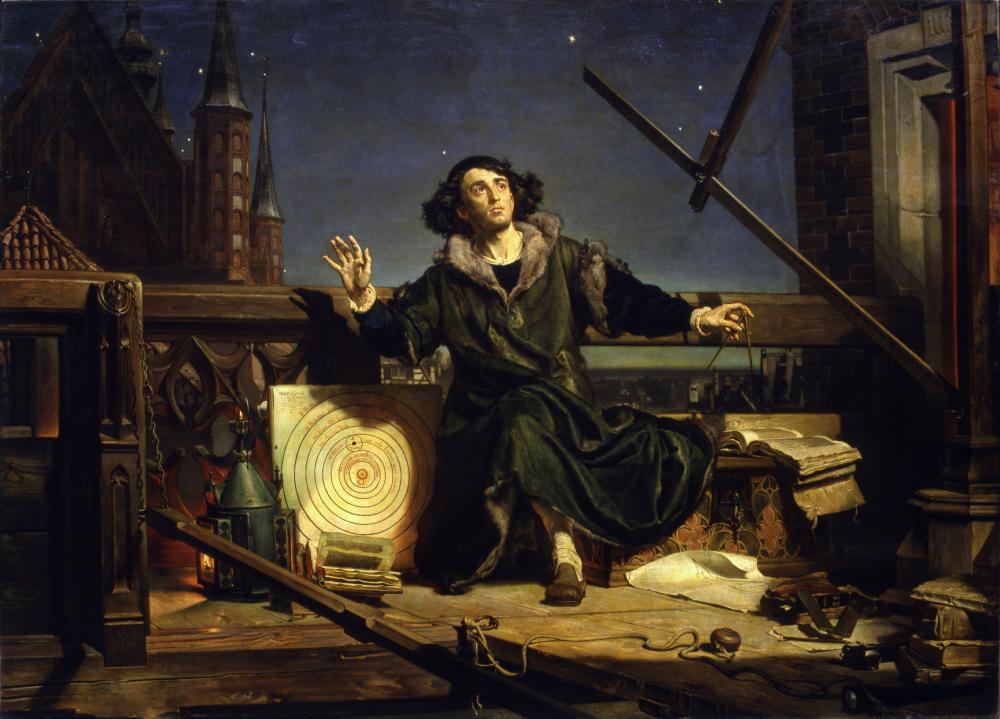
Fig. 5a. Copernicus's 'Observatory' in Frombork -- Conversation with God (painting by Jan Matejko)

Fig. 5b. Armillary Sphere (Replica) of Copernicus in Frombork

Fig. 5c. Quadrant (Replica) of Copernicus in Frombork
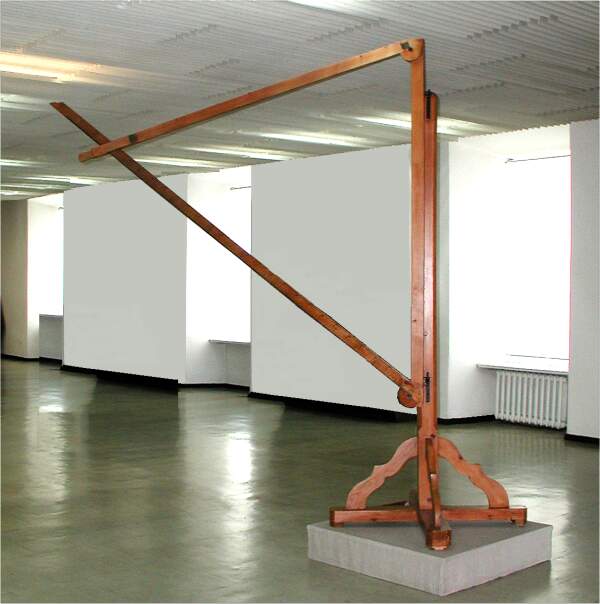
Fig. 5d. Triquetrum (Replica) of Copernicus in Frombork
Instruments of Copernicus
- Replicas of Copernicus instruments: Armillary Sphere, large Quadrant, Triquetrum.
In the former Bishop's Palace (Ferber Palace) is today a Copernicus Museum (Muzeum Mikołaja Kopernika).
In the Holy Spirit Hospital, where Copernicus was active as physician, the Medical History Department of the Nicolaus Copernicus Museum is presented (Muzeum Medycyny).
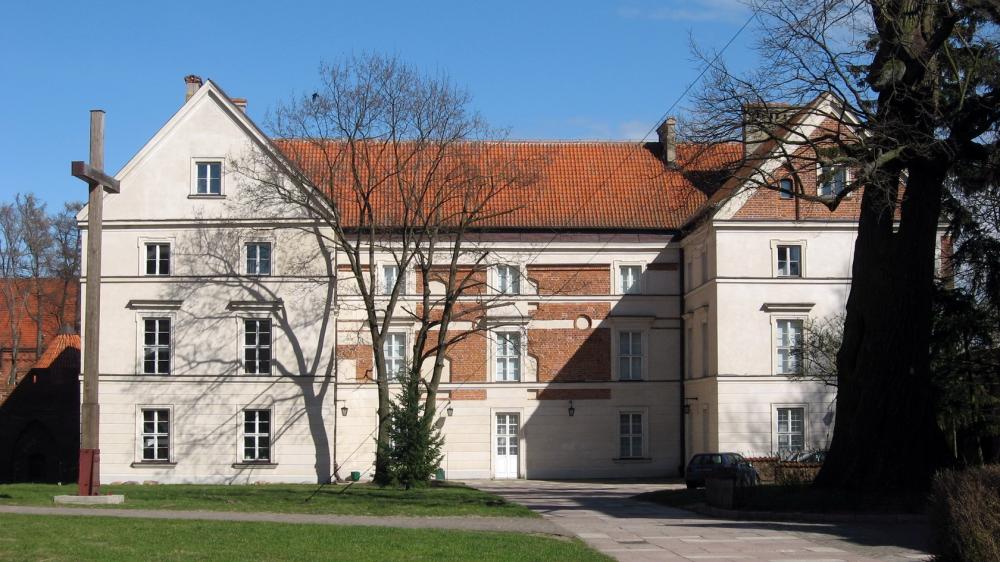
Fig. 6a. Former Bishop’s Palace, now museum (CC3, Tomek Zakrzewski)

Fig. 6b. Holy Spirit Hospital

Fig. 6c. Copernicus Exhibition in the former Bishop’s Palace
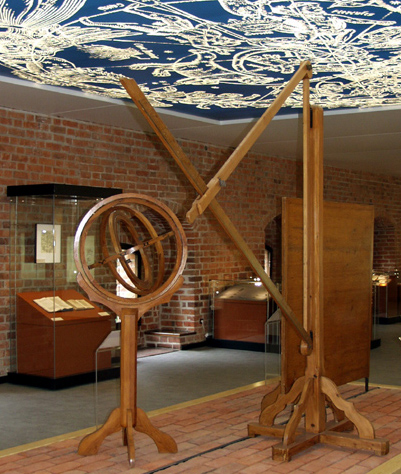
Fig. 6d. Replicas of Copernicus’ instruments in the Museum
In the Cathedral, there is the Epitaph, tombstone at the altar of the Holy Cross, and the Grave of Copernicus.
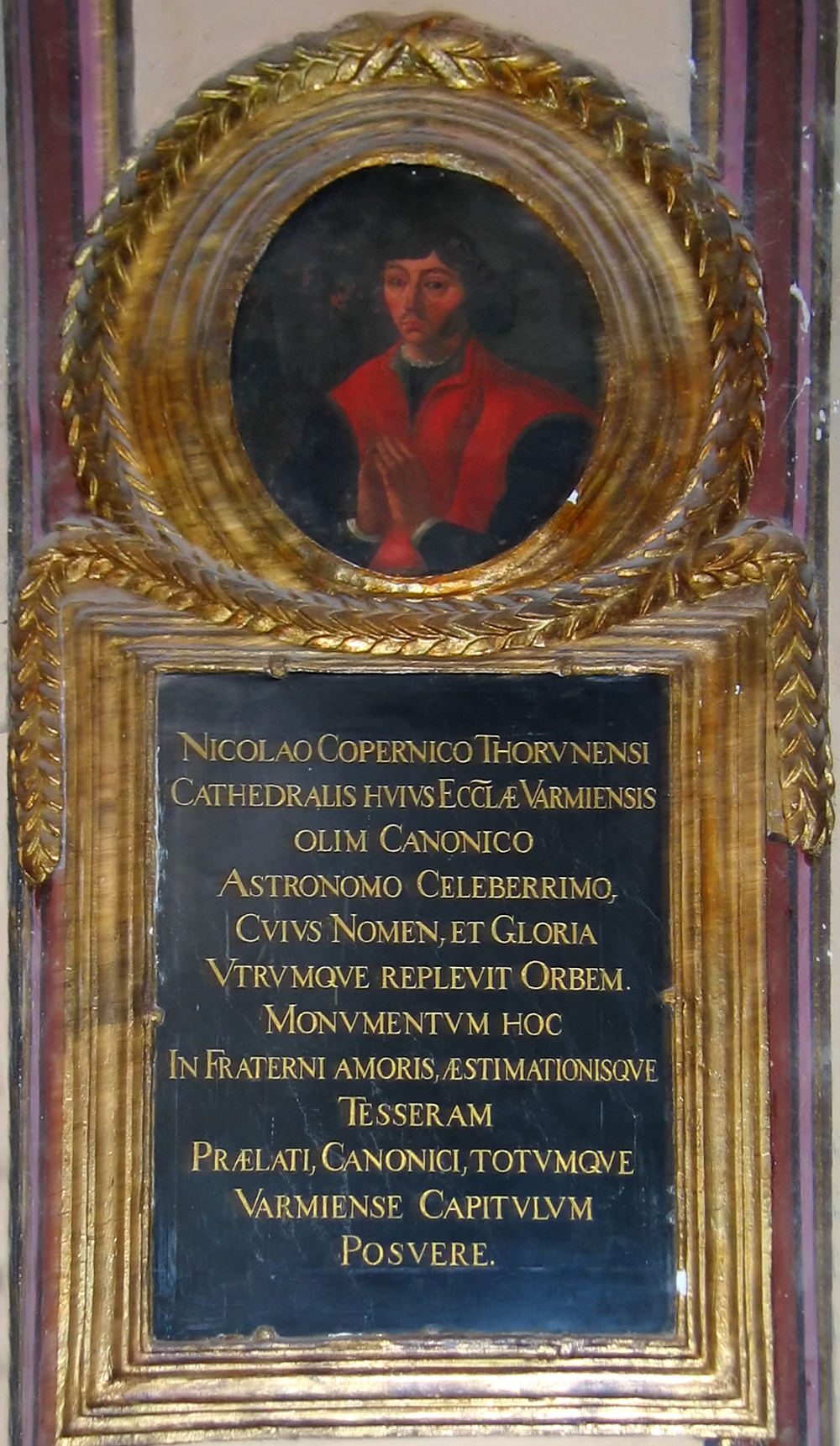
Fig. 7a. Epitaph of Nicolaus Copernicus
Fig. 7b. Tombstone of Nicolaus Copernicus (Photo: Ansgar Korte)
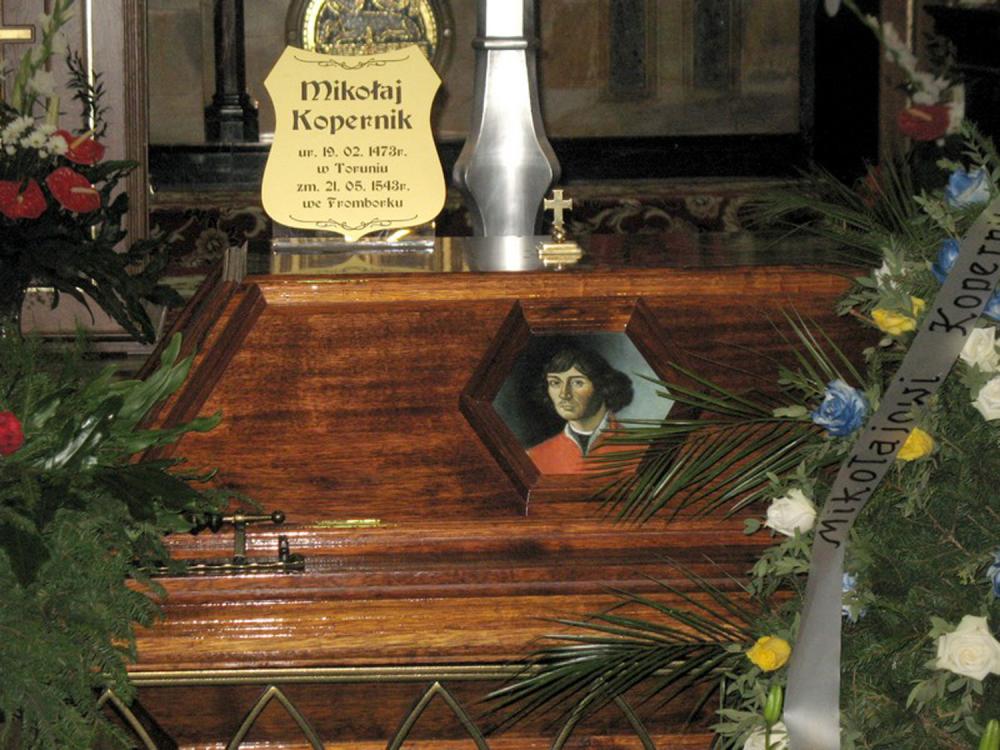
Fig. 7c. Grave of Nicolaus Copernicus (Photo: Ansgar Korte)
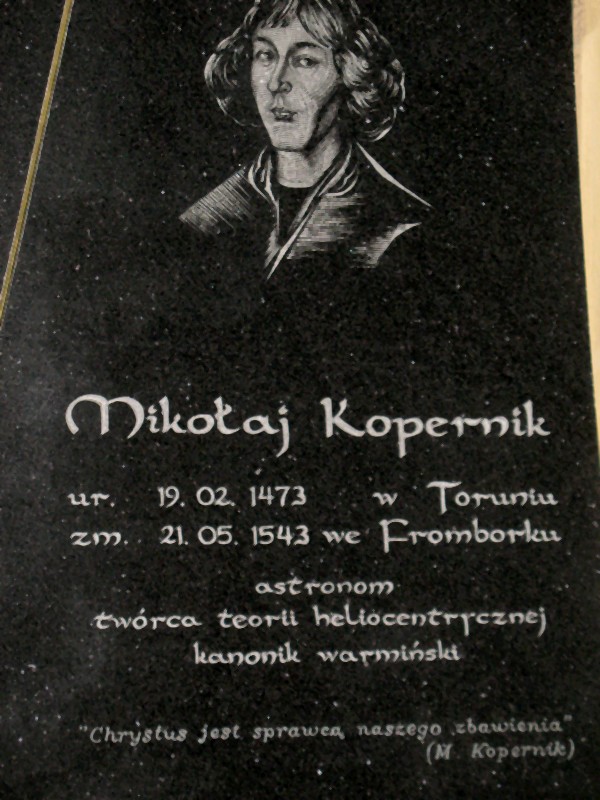
Fig. 7d. Text on the Tombstone of Nicolaus Copernicus (Photo: Ansgar Korte)
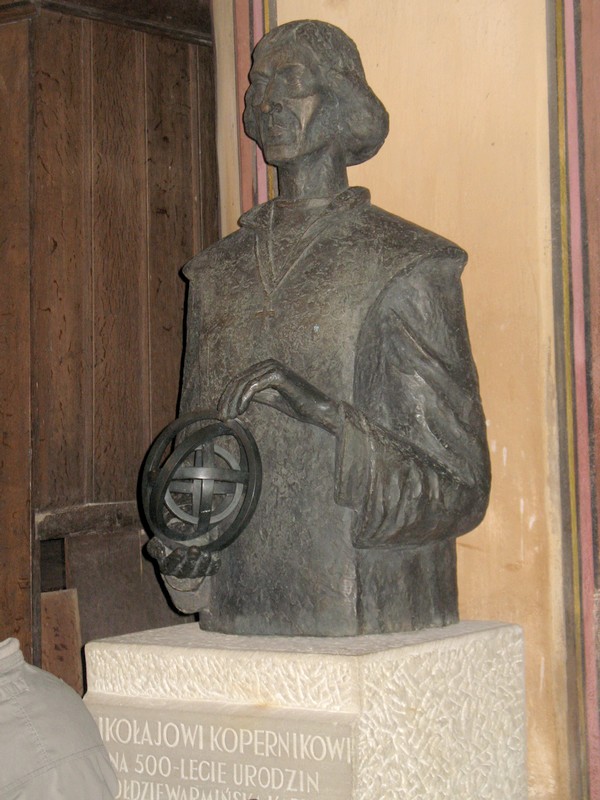
Fig. 7e. Statue of Nicolaus Copernicus (Photo: Ansgar Korte)
History
Modern Astronomical Observatory in Frombork
2 km from Frombork, on a hill called Żurawia Góra (Crane Mountain), there is the Astronomical Observatory Frombork, Ronin 7, seven pavilions with instruments for star gazing.
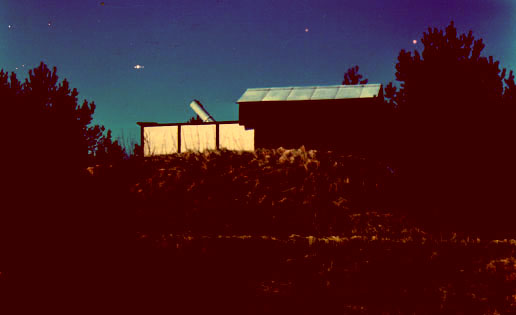
Fig. 8a. Public Observatory in Frombork (credit: Edith Pilska)
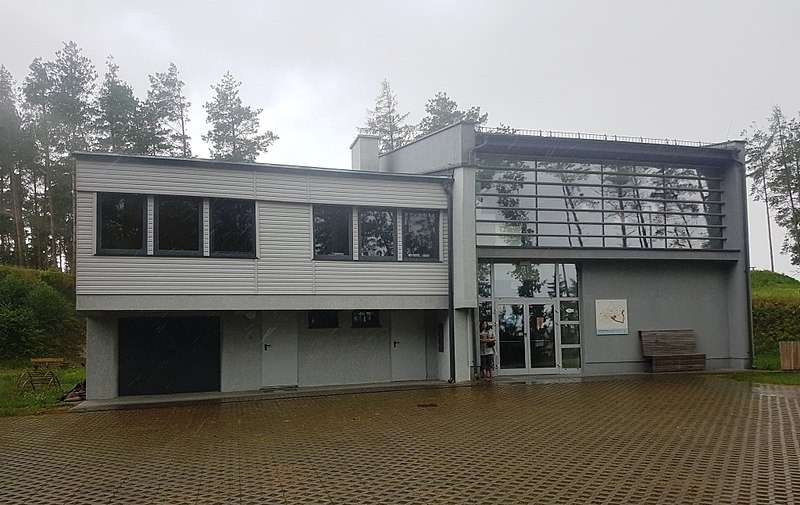
Fig. 8b. Astro-Park -- Observatory in Frombork (credit: Edith Pilska)
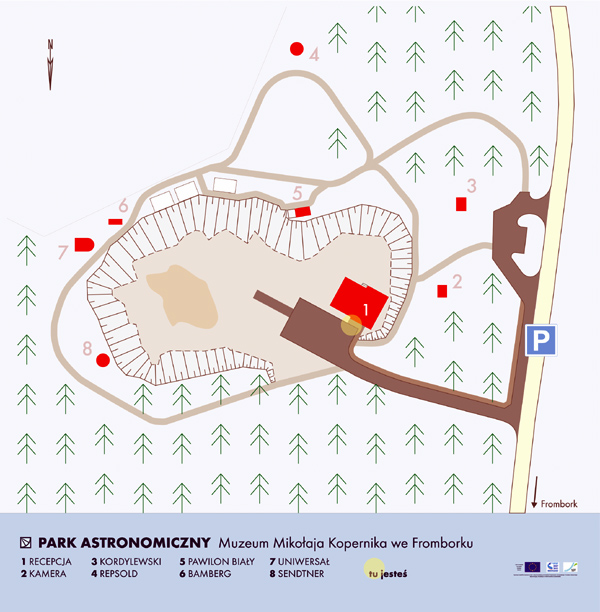
Fig. 8c. Astro-Park -- Pavilions of the Observatory in Frombork (credit: Edith Pilska)
Instruments and Buildings of the Astro-Park Frombork
- Reception Building
- Astrograph (Kamera)
- Kazimierz-Kordylewski-Telescope
- Repsold
- White Pavilion (Pawilon Bialy)
- Carl Bamberg
- Universal Instrument
- 12.5-cm-Heyde-Sendtner Telescope (1930), focal length 2.7-m in a 5-m-Dome, made by Gustav Heyde of Dresden and M. Sendtner of Munich.
First it was used in an Observatory in Danzig/Gdańsk (not in the Oberrealschule zu St. Petri und St. Pauli, may be in the "Danziger Naturforschende Gesellschaft" or in the Navigation School)
It belonged to Warsaw Observatory (1956), then since 1972 in the School Observatory Grudziądz, and was transferred to Frombork in 1978. - 65-cm-Cassegrain-Reflector, made by Uniwersał (focal length 6.88m)

Fig. 8a. Heyde-Sendtner-Telescope in Danzig/Gdańsk (1930), (credit: Edith Pilska)
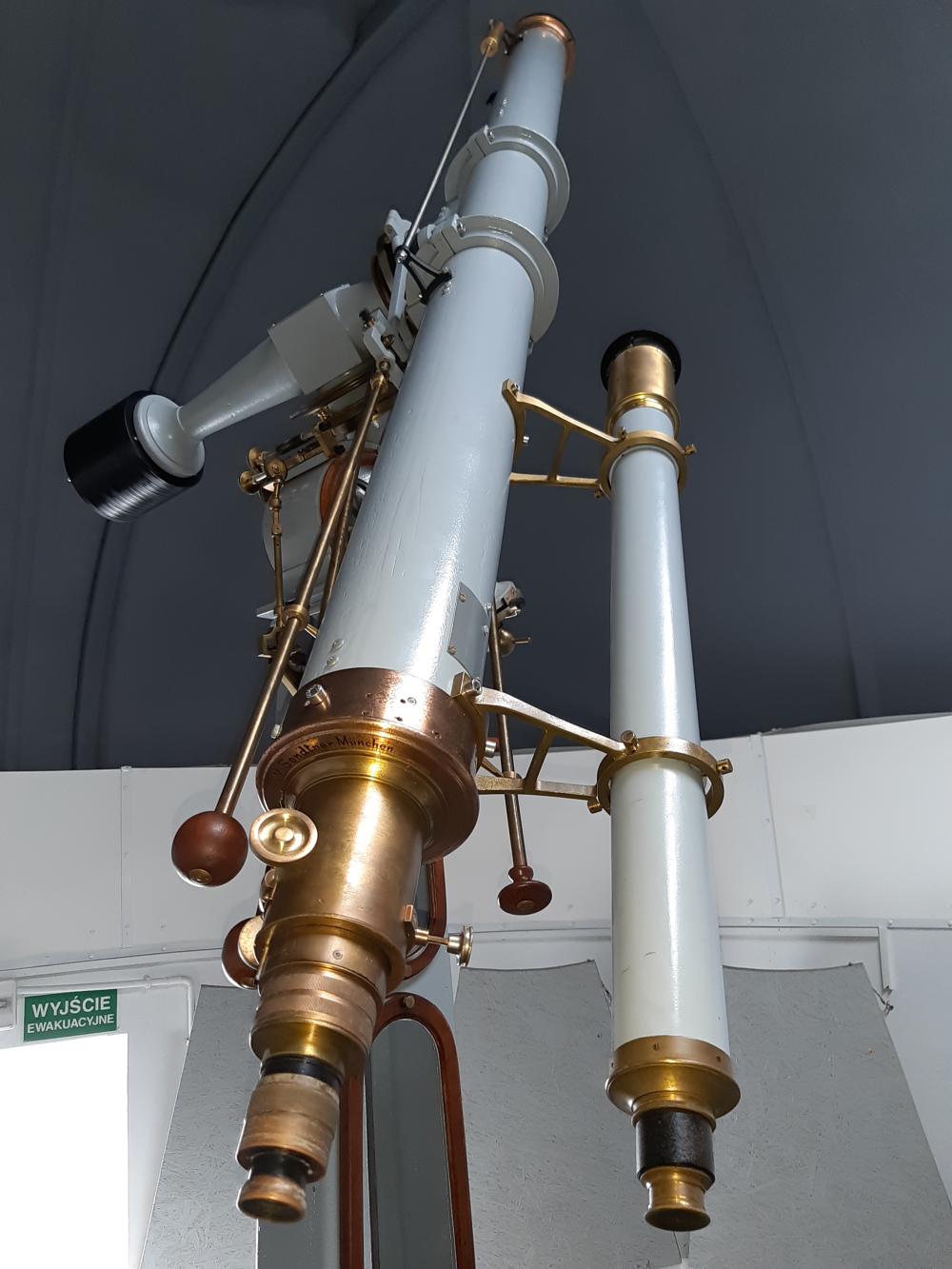
Fig. 8b. Heyde-Sendtner-Telescope in Frombork (credit: Edith Pilska)
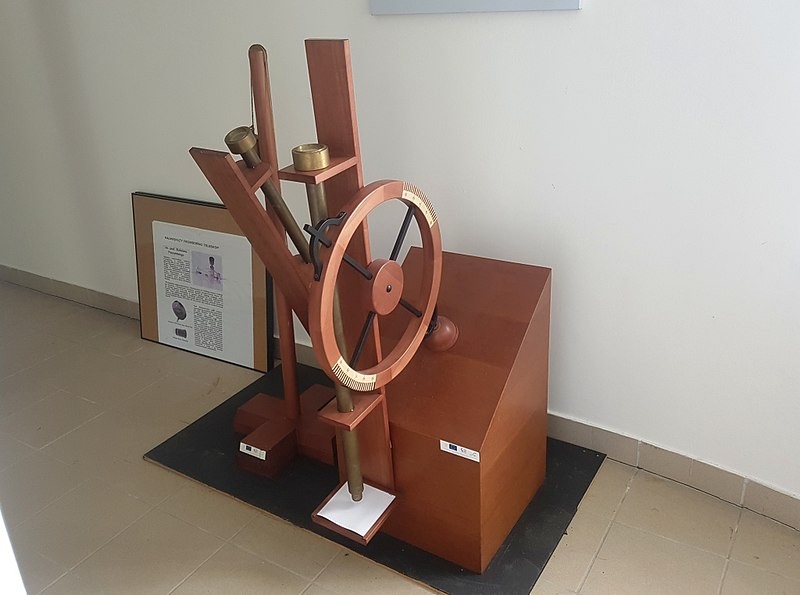
Fig. 8c. Telescope for observing the Sun in Frombork (credit: Edith Pilska)

Fig. 8d. Transit, made by Carl Bamberg of Berlin in the Observatory in Frombork (credit: Edith Pilska)
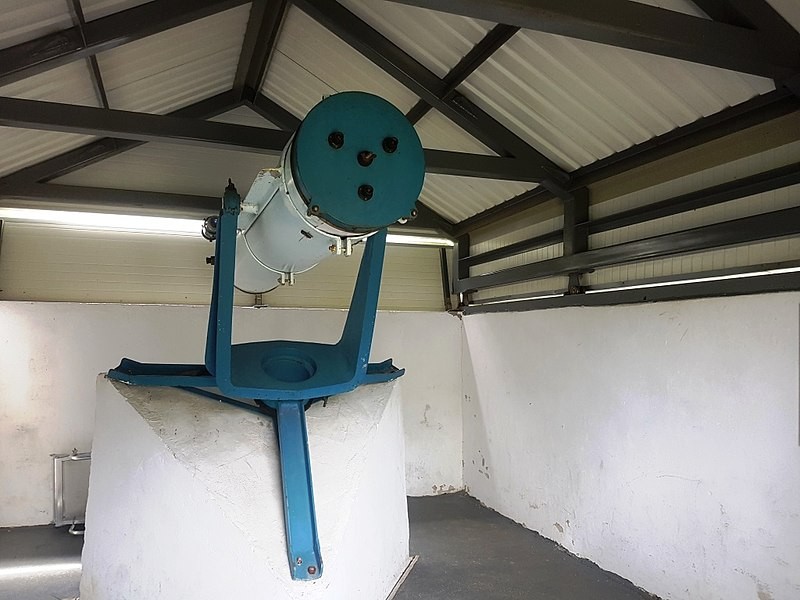
Fig. 8e. 65-cm-Cassegrain-Reflector, made by Uniwersał (focal length 6.88m), in the Observatory in Frombork (credit: Edith Pilska)
State of preservation
The Frombork (Frauenburg) Cathedral Complex with the Cathedral surrounded by brick fortifications, with more buildings like the Bishop's Palace is ell preserved and monument protected -- a Historic Monument of Poland (1994-09-08, M.P. z 1994 r. Nr 50, poz. 414):
Category: ecclesiastical complex
Building material: brick
Protection: Historical Monument
Inspire id: PL.1.9.ZIPOZ.NID_N_28_PH.8445
(cf. Ancient and Medieval Architecture -- Frombork Cathedral Hill)
The Frauenburg / Frombork fortified castle "castrum dominae nostrae" above the Vistula Lagoon was first recorded in 1278 -- Warmian diocese and the cathedral chapter (1288). The brick fortifications around the cathedral hill were erected in the 14th century. The cathedral with a very decorated western gable and porch, and no chruch tower, but four small corner turrets, was built from 1342 to 1388 with a length of about 97-m, and a width of 12.4-m (chancel in the East) to 25.2-m (nave).
The buildings on the castle hill were partly destroyed by Polish-Lithuanian troops in 1414, and by the Teutonic Knights in 1455. The reconstruction was made by Bishop Lucas Watzenrode after 1499 with improved fortifications in the 15th and 16th centuries (Bishop Maurycy Ferber built a barbican as southern gate in 1537). Residential buildings were damaged by the Swedes in the years 1626-1630 and 1655-1660.
The Radziejowski's Tower is an octagonal cannon tower in the SW corner, built before the mid-15th century, with a belfry (belltower) in half-timbered structure built on it (1448). This was the place, where Nicolaus Copernicus lived from 1510 to 1543. From the top of the Belfry, you get a striking panorama.
There was a mixture of buildings: fortified, ecclesiastical, residential and administrative -- the Cathedral (Gothic, hall structure), the Belfry Radziejowski Tower, the parapet walk with the towers, and additional buildings like the former Bishop's Palace (Pałac Biskupi).
In front of the cathedral is a large monument of Copernicus who worked as a canon in the Ermland Chapter. A stone nearby with an epigraph contains the name Nicolaus Copernicus in Polish spelling as well as the following translated text: "Society of Warmia and Masury"
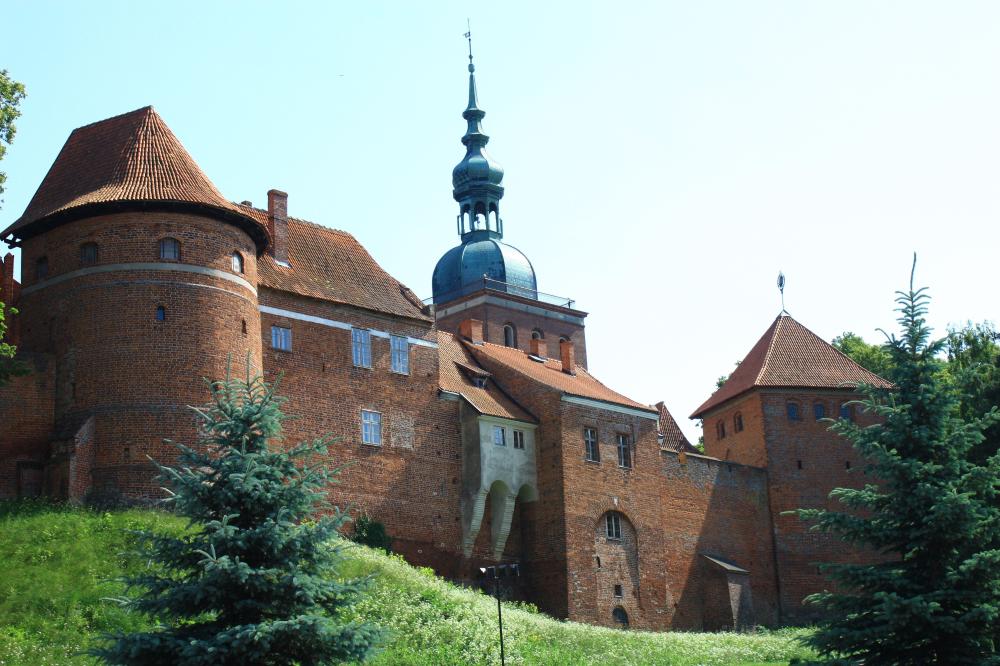
Fig. 9a. Frombork Cathedral Hill, Belfry Radziejowski and Copernicus-Tower (CC3, Dawid Galus)
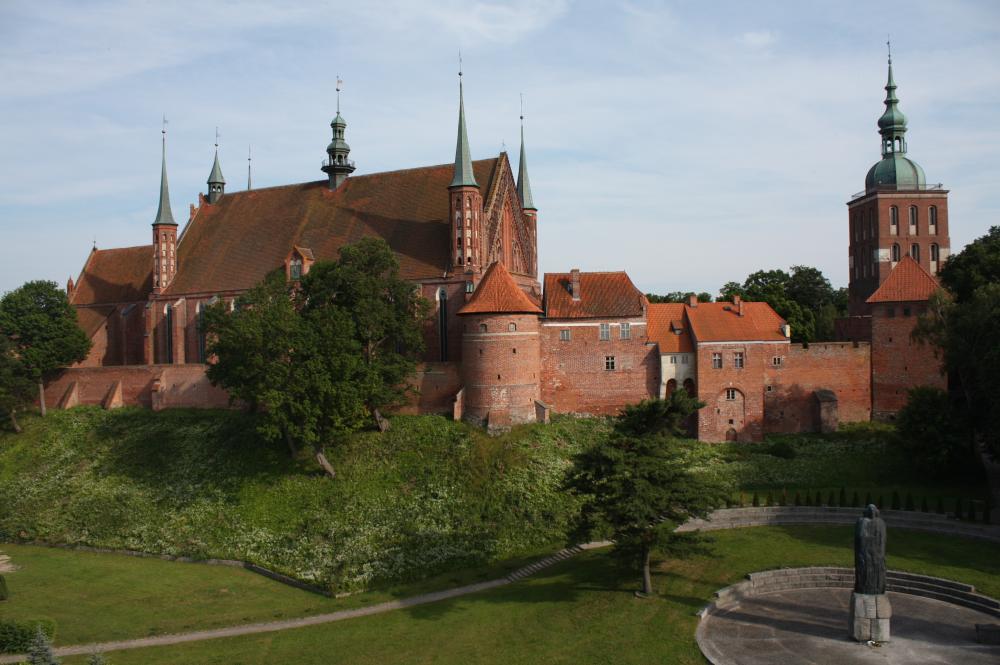
Fig. 9b. Cathedral Hill Frombork with Copernicus Statue (CC3, Ludwig Schneider)
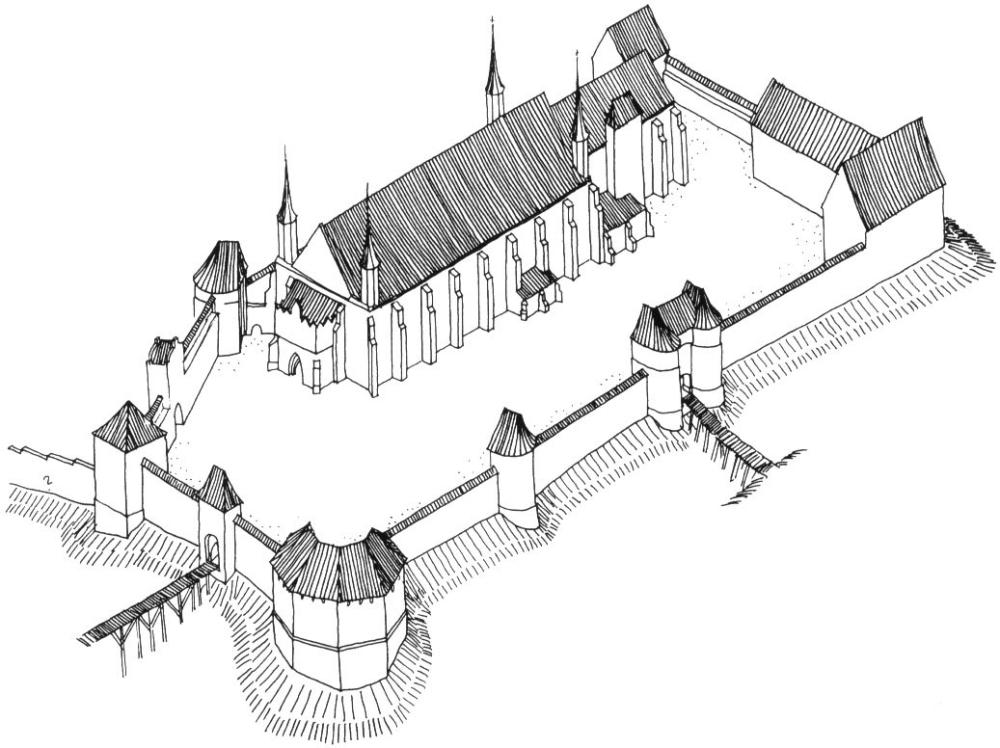
Fig. 9c. Reconstruction of the cathedral hill in the late Middle Ages according to T. Zagrodzki (graphics: T. Zagrodzki)
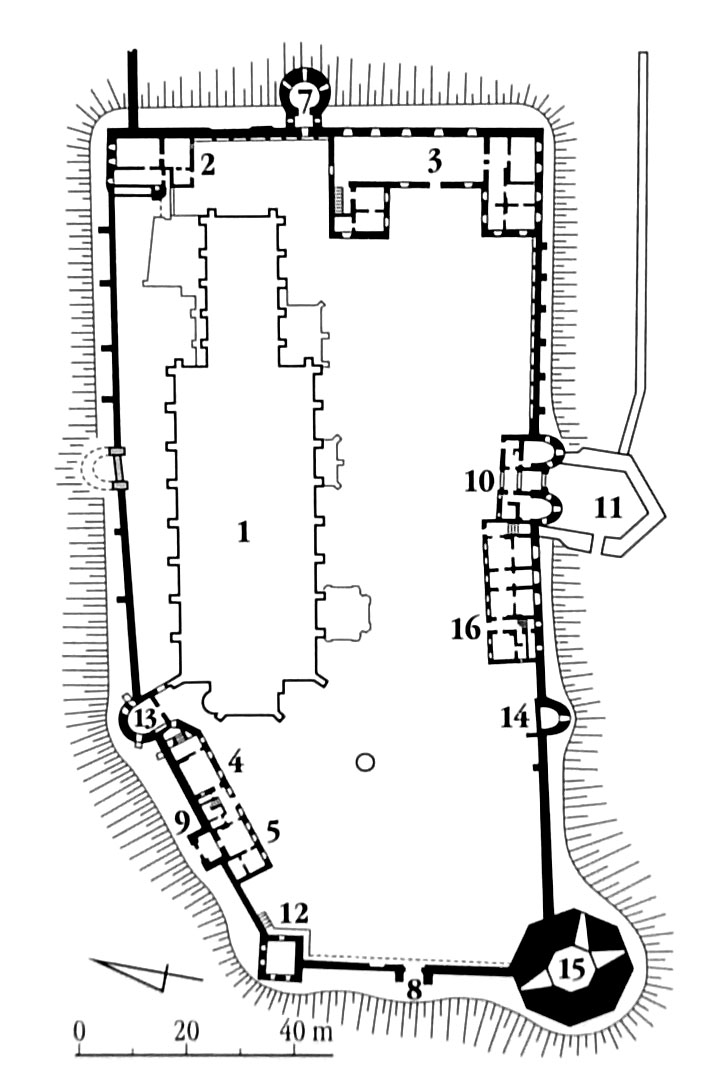
Fig. 9d. Layout of the cathedral hill according to M. Garniec: 1-cathedral, 2-chapter house in the NE corner, 3-bishop's palace with cathedral school in the SE corner, now museum, 4-custodian house, 5-curia, 7-eastern tower, 8-west gate, 9-north wicket gate, 10-south gate, 11-remains of barbican, 12-Copernicus Tower, 13-Custody Tower, 14-Gunpowder Tower in horseshoe shape, 15-Belfry Radziejowski's Tower (octagonal cannon tower in the SW corner, mid-15th century) Copernicus residence, 16-vicariate (graphics: M. Garniec)

Fig. 9e. Copernicus Statue in front of the Cathedral Hill Frombork (photo: Wolfgang Volk, 2003)
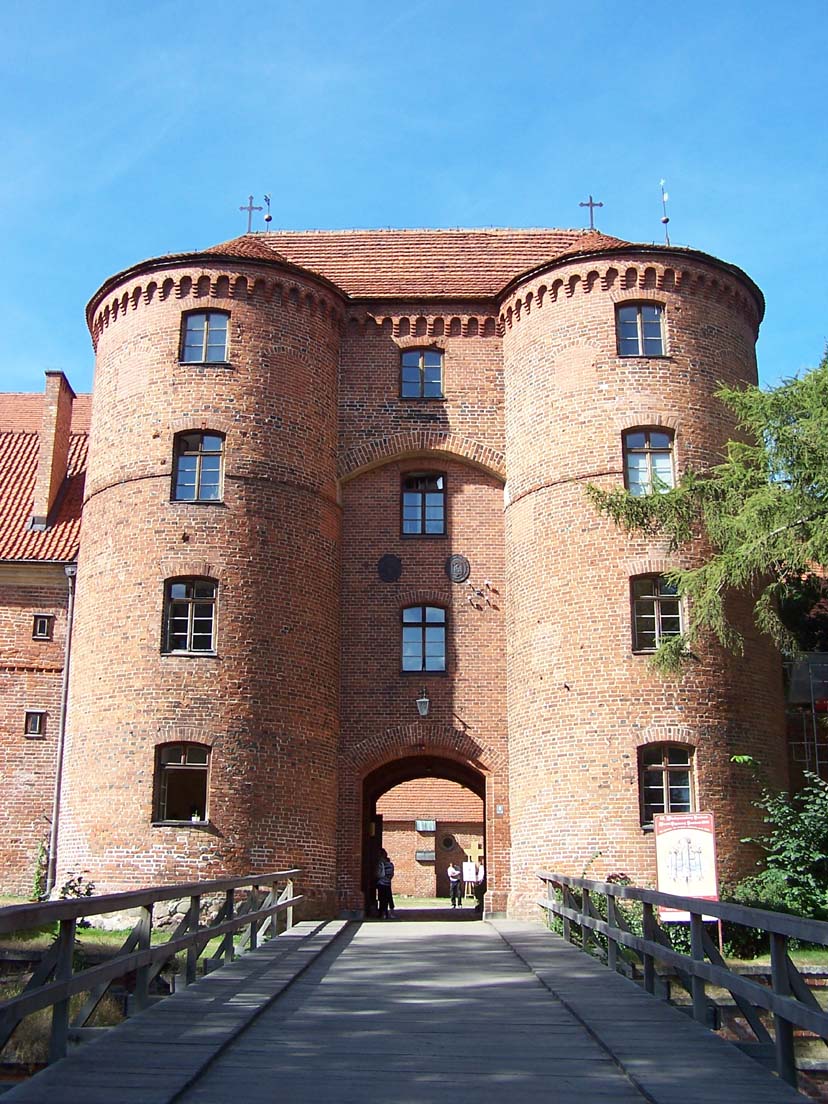
Fig. 9e. Cathedral Hill Frombork - South-Gate Barbican (photo: J. Michale, Frombork - Cathedral Complex)
Comparison with related/similar sites
This Copernicus observing site in Frauenburg / Frombork, Poland is comparable to other places, where Copernicus was active:
- Collegium Maius at the time of Copernicus, Jagiellonian University, Kraków/Cracow, Poland
- Heliograph (Astronomical Table), Olsztyn/Allenstein Castle, Poland
Threats or potential threats
no threats
Present use
The Cathedral Frombork is still used, also as a memorial place for Copernicus.
In addition there are buildings devoted to a Copernicus Museum and a planetarium.
Planetarium Frombork
In the former Cathedral Bell Tower (Belfry Radziejowski Tower), there is a planetarium, and a Foucault pendulum showing the rotation of the Earth. From the platform on the top of the tower, you have a beautiful view of the town of Frombork and of the Vistula Lagoon.

Fig. 10a. Projector of the Planetarium in Frombork (credit: Edith Pilska)
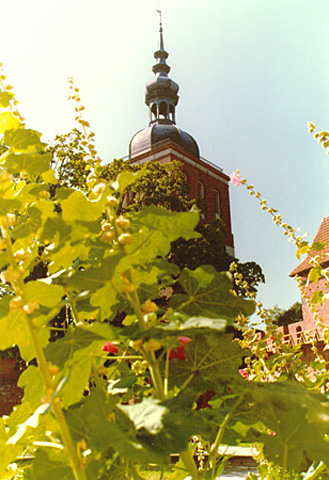
Fig. 10b. Cathedral Bell Tower (Belfry Radziejowski Tower) with Foucault pendulum in Frombork (credit: Edith Pilska)
Astronomical relevance today
Activities are made for presenting astronomy for the public.
The Belfry Radziejowski Tower is used for a planetarium,
other buildings for an astronomical museum showing the history of Copernicus and his work.
References
Bibliography (books and published articles)
- Borawska, Teresa & Henryk Rietz: Mikołaj Kopernik i jego świat. Środowisko. Przyjaciele. Echa wielkiego odkrycia [Nicolaus Copernicus und seine Welt. Sein Milieu. Seine Freunde. Das Echo einer grossen Entdeckung]. Toruń: TNT 2014, p. 409--453.
Rietz, Henryk: Nicolaus Copernicus Grab im Dom zu Frauenburg gefunden und die sterblichen Überreste identifiziert? Wissenschaftliche Forschungen oder Fälschungen? - Brachvogel, Eugen: Frauenburg, die Stadt des Koppernikus. Elbing 1933.
- Reifferscheid, Gerhard: Der Dom zu Frauenburg: ermländische Kathedrale über dem Frischen Haff. Münster: Bischof-Maximilian-Kaller-Stiftung 1985.
- Tirado, M.A. Castro: Astronomical Observatories: From the Prehistory to the XVIII Century. In: RMxAA (Serie de Conferencias) 51 (2019), p. 1--8.
- Volk, Wolfgang: Zeugnisse zu Mathematikern -- Monuments on Mathematicians (2013).
-
Wolfschmidt, Gudrun (ed.): Nicolaus Copernicus (1473-1543) -- Revolutionär wider Willen. Nicolaus Copernicus (1473--1543) -- Revolutionary against his Will. Begleitbuch/Katalog zur Ausstellung im Zeiss Großplanetarium in Berlin, Juli bis Oktober 1994.
Mit Beiträgen von Liba Taub (Chicago), Heribert Nobis (München), Fritz Krafft (Marburg), Felix Schmeidler (München), Andreas Kühne (München), Menso Folkerts (München), Gundolf Keil (Würzburg), Karin Figala, Uli Petzold (München), Paveł Czartoryski (Warschau), Günther Meinhardt (Göttingen), Wolfgang Neuser (Heidelberg), Jürgen Teichmann (München), Michael Segre (München), Eberhard Knobloch (Berlin), Volker Bialas (München), Ivo Schneider (München), Rainer Baasner (Bonn) und Karl Märker.
Stuttgart: Verlag für Geschichte der Naturwissenschaften und Technik 1994. - Wolfschmidt, Gudrun: Astro Walk in the footsteps of Copernicus and Kepler. In: Between Ancient and Modern Astronomy. Proceedings of the 30th SEAC, Polish Academy of Sciences, Warsaw, Poland, September 6-9, 2023. Ed. by Michal Giłewski. Warsaw 2024.
Links to external sites
- Muzeum Mikołaja Kopernika we Frombork
- Frombork, Wikipedia
- Ball, Robert S.: Great Astronomers
- Mazury.Travel -- Na szlaku z Kopernikiem -- miejsca, gdzie zyl i pracowal wiełki astronom.
This trail leads through unique places. It is nearly 300 km of an exciting journey in the footsteps of great discoveries that forever changed the perception of the universe. In Warmia, Copernicus spent 40 years of his life as a canon of the Warmia chapter, and regardless of that, he observed the sky, worked on the heliocentric theory and wrote down his work.
The Copernicus Trail in Warmia and Mazury leads through the cities of: Elbląg, Tolkmicko, Frombork, Braniewo, Pieniężno, Orneta, Lidzbark Warmiński, Dobre Miasto, Olsztyn, Olsztynek, Lubawa and Nowe Miasto Lubawskie. No matter where you start your journey, be ready for great discoveries. - The greatest attractions in Frombork
- Młynarczyk, Robert: Ancient and Medieval Architecture -- Frombork Cathedral Hill
- Frombork Cathedral Complex
No multimedia content published
Currently there is no multimedia content published for this case study






